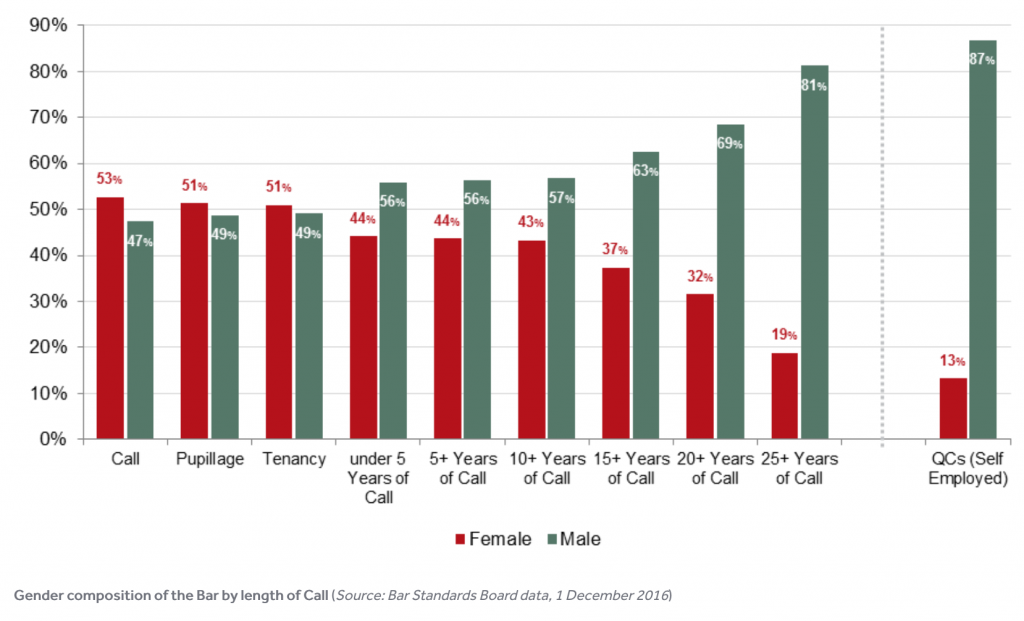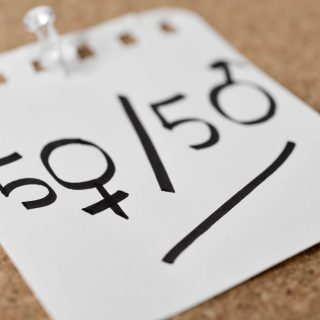I am going to introduce you to Professor Jo Delahunty, who gave a lecture at Gresham College, the first of a series ‘Transparency in the Family Justice System‘. This talk was entitled ‘Women Lawyers: Equals At The Bar?’.
If my review catches your attention, you can also watch Jo’s lecture via YouTube.
Delahunty’s own experience stems from life as a middle class, white woman who was raised in a single parent home, with working class roots. Happily married, three children. Oh, and a senior silk (QC), bencher and part-time judge.
She considers the word ‘barrister’ to be gender neutral, yet just over two decades have passed since May 1995, when the Lord Chief Justice relaxed the no-trousers rule that permitted women to only wear a dress or skirt. Women not abiding by the rule risked compromising their client’s success, because a judge would not entertain the submissions of the ‘inappropriately dressed’. Yes, this means permission was given to female barristers that they could join their male colleagues in the privilege of wearing trousers, how kind! Called to the bar in 1986, Jo reflected on some sexist instances she had experienced, such as the time she was told to spread her legs and sit on a client’s lap, to which her pupil master chuckled. Or when, after delivering a commanding submission to the judge, she was mistaken to be a waitress by a fellow barrister in the robing room.
Akin to a social bar, men seem to be hogging all the drinks, all the barstool spaces and the VIP section in this club. Sounds like we are in need of an epic ladies night, which Delahunty was happy to host as she paid homage to some iconic women and iconic moments that have challenged the status quo. Gwyenth Bebb, in the case of Bebb v The Law Society [1914] 1 Ch 286, concerning her application to become a member, made it to the Court of Appeal, and yes, she lost the case, however the court did acknowledge Miss Bebb as being ‘probably, far better than’ a lot of the male candidates, but this is 1913, where women were allowed to thrive only in the private sphere and before the Sex Disqualification (Removal) Act 1919 ‘an Act to amend the Law with respect to disqualifications on account of sex‘. There was Dame Rose Heilbron DBE QC, one of the first women to gain a first class honours in law at Liverpool University in 1935, an then a masters in 1937; the first woman to win a scholarship at Gray’s Inn; one of the first women to be appointed to the King’s Counsel in England; first female recorder; first woman to lead in a murder trial; first woman to sit as a judge at the Old Bailey, shall I continue? Lady Justice Hallett DBE, the first woman to chair the Bar Council. HHJ Anuja Ravindra Dhir QC, the youngest -at 49- and first non-white judge to sit at the Old Bailey. Lady Brenda Hale, or Baroness Hale of Richmond, whose coat of arms bear the stitching which reads: ‘Omnia Feminae Aequissimae’, which translates as ‘women are equal to everything’, became the first female law lord and is the current President of the Supreme Court. How about Gabrielle Turnquest? At 18 Miss Turnquest passed the bar exam, the youngest person in the world to do so. White or otherwise. And it was Senior Circuit Judge HHJ Taylor Deborah who expelled the Southwark robing room rule that a specific room, located closest to the courtroom, which was more spacious and contained work spaces, was exclusively for the male barristers. She made it unisex, gender equality at its finest. The previous set-up excluded female barristers from important pre-court verbal communication that at times led to agreements being made.
Moreover, let us not forget Jo Delahunty’s mother, who made it her mission to give her children a life with more opportunities than her own. Jo remembers her mother “researching the colleges and driving me down to Oxford, tipping me out at St Anne’s to go and ask for an interview.”
Despite these successes, the reason they are considered iconic is because they are not common. Yet. “Large numbers of women are leaving the profession,” said Jo. The reality of careers for women at the bar, is that the retention rate drops, usually in correlation to the ticking of the biological clock. In fact, up till the step of obtaining a pupillage, the ratio of women to men is pretty level, and that is undeniably progress. The split occurs a short while after they become a barrister in practice, with statistics in 2010 showing a retention of 45% of female barristers at 5 years of call, and in 2015 an appalling 29% retention at 15+ years of call. And the number of female representation in the judiciary as a whole? Even more ghastly. The judiciary in 2015-2016, at its worst, showed the number of women in ‘Heads of Division’ to be 0%, and the highest percentage of women being 36%, as Deputy District Judges (County). The Barristers Working Lives Report 2013 found that female barristers, more of whom work in the publicly funded Bar, are worse impacted by the slash in public capital. The Bar Council Report 2014 discovered the primary reasons for leaving their bar career to be: income, child caring responsibilities, an increase in expected pro bono work and the impact of criminal legal aid cuts. Further research, like that detailed in the Bar Standards Board (BSB) Equality and Diversity Committee 2016 report, revealed a mere 13% of the Queen’s Counsel to be women.
So we now have an idea of the problems; low representation, low funding and low retention. Why are women at the bar facing these circumstances? Jo believes that:
“social inequality is the biggest factor, not gender.”
In 2013, the BSB said ‘women may face systematic disadvantage in silk applications because of their secondary school, university and area of practice.’ Four years later, the prejudice remains. “We are an invisible society”, is what Delahunty identified as a significant factor that separated life at the bar from other professions. Unlike your standard 9-5 office employer-employee set-up, a barristers’ chamber contains self-employed individuals, with each set differing in character. It is easy to remove accountability, for example, the Bar Council’s Guidelines to flexible working not being applied by all, when you are not an organisation in the public eye. However Jo feels that a duty is owed to the public, who deserve a bar make up which reflects a fair society. This is the only way to ensure justice, as well as the confidence of citizens that allows democracy to be a working concept in this country, as opposed to the ‘Enemies of the People’ balderdash which emerged after the Miller (2016) judgment. A diverse judiciary can only aid advancement in the law.
The Women at the Bar Report 2016 found that improvement was required in: the profession’s culture, compliance and awareness of the Equality Rules and increased support towards flexibility and childcare commitments. The profession’s cultural matters of contention include: bullying, locker room banter, work allocation and its attitude to harassment, a problem that has not seemed to buzz off, for the past 15 years, according to every 2 in 5 female barristers surveyed by BSB in 2016. Women feel wary to report such incidences for fear of how it will backfire on their reputation, and by extension, their career.

The solution? Become visible, in schools, working with university law departments, hosting open days. Chambers can hold each other accountable by publishing relevant figures showing how things currently are and the progress that can be made. The Judicial Appointments Commission (JAC) commitment to a better, more diverse judiciary has achieved little beyond the district and tribunal level. Therefore, the organic approach to change clearly needs be replaced with more proactivity. A game changer could be on its way, as the JAC expects to run a selection exercise directed at highly skilled lawyers and academics from non-traditional backgrounds, to sit in the High Court, in early 2018. To prepare for this, the Judicial Diversity Committee’s 2017 High Court Support Programme has been created, offering a workshop and shadowing of a High Court Judge. The ‘Balancing the scales: A study into the under-application by women for appointment as Queen’s Counsel’ report has made a few suggestions: amplify female QC role models; develop existing mentoring schemes; evolve the QC Appointments website so that the application is clear and the ambition of having a higher amount of female applicants is evident; for QC Appointments to work alongside stakeholders in widening the pot of female junior barristers on route to reaching qualifying levels for QC status. Why not embrace them? “Swiftly” is Jo’s advice. Additional recommendations can be unearthed in the JUSTICE, or Judicial Diversity Working Party 2017 report called ‘Increasing Judicial Diversity’ and ‘Snapshot: The Experience of Self-Employed Women At The Bar’. We can lift one another up.
“It had never occurred to me that someone like me could be a judge, until it was pointed out to me by another woman”
….said Jo. The Temple Women Forum was started in 2012 by Middle Temple, which has now been embraced by its sister inns. In the first female Treasurer of Middle Temple, Master Dawn Oliver’s words, “the intention was to provide support for women…discuss their experiences and give advice”. Still thriving today, the forum gives women at all levels of the profession a voice. The Association of Women Barristers (AWB) was established in 1991, to support Women at the English Bar, and offers mentorship and role models, companionship on social occasions and acts as a watchdog to all that affect women at the employed and self-employed Bars.
A ‘glass ceiling’? Oh, you mean that smashable material preventing fresh air? Well lets put in some windows ladies and gents, with accessible handles.

If you would like to hear more from Jo Delahunty, her next lecture takes place at Barnard’s Inn, and is called ‘What do judges do in the Family Court?’. More details can be found at the Gresham College website. You can tweet her @JoDQC.
Thanks to Oluwakemi Onile-Ere (LLB2) for this comprehensive review of the Gresham College talk. Look for more of Oluwakemi’s reviews in the coming year!


